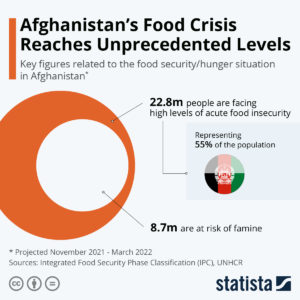
Afghanistan is in crisis. Extreme hunger acutely threatens the lives of millions of Afghans. Ninety-five percent of the population currently does not have enough to eat, and access to food is rapidly deteriorating. Already undergoing one of the world’s most severe humanitarian disasters, worsening economic conditions are expected to further erode the population’s ability to meet its basic needs. If left unaddressed, the current humanitarian crisis could lead to more deaths than twenty years of war.

The Core Cause of the Crisis
Since the fall of the Afghan government and subsequent Taliban takeover in August 2021, the economy has collapsed. Foreign aid, responsible for nearly 45% of GDP and 75% of the government’s spending, has been cut off, and under international sanctions against the Taliban, roughly $9 billion of Afghan assets in overseas banks are frozen, paralyzing the country’s banking system. Shortages of cash significantly constrain the ability of businesses to pay their workers, and the United Nations Development Programme warns that unemployment could rise by over 40%. The crisis is fueled by catastrophic disintegration of economic policy.
“If state collapse was the object of policy, it could hardly be better designed.”
David Miliband, President and CEO of the International Rescue Committee during a Senate Foreign Relations Committee (SFRC) Hearing on Afghanistan: The Humanitarian Crisis and U.S. Response
Comorbid Catastrophe
This economic catastrophe strikes while the COVID-19 pandemic still surges throughout the country. Only 10% of Afghans are fully vaccinated and the already fragile health system is being pushed to the brink. Dozens of COVID-19 health facilities were forced to close due to lack of medicines, medical supplies, and an inability to pay salaries of health workers. Currently, fewer than 10 of the country’s 37 public COVID-19 health facilities remain functional, and they are unable to keep up with demand.
Multilateral Global Response
The world’s multilateral organizations are rushing to respond. Due to the severity of the crisis, the United Nations (UN) launched its largest ever single country appeal for humanitarian assistance in January – $4.4 billion for 2022, alone. In an address to the UN Security Council, UN Secretary-General António Guterres emphasized: “As a matter of moral responsibility – and regional and global security and prosperity – we cannot abandon the people of Afghanistan.”
In March 2022, the World Bank approved a provision of over $1 billion in funds from the Afghanistan Reconstruction Trust Fund, in the form of recipient-executed grants to selected United Nations agencies and international NGOs. The implementation of these funds will remain outside the control of the interim Taliban administration.
U.S. Response
The United States has been a key contributor in response to the crisis and has made significant progress towards finding pragmatic solutions. The Biden Administration has shown a clear commitment to assisting vulnerable Afghans, as the United States remains the single largest provider of humanitarian assistance to Afghanistan. Following a January 2022 USAID announcement of more than $308 million in assistance for the people of Afghanistan, the United States has totaled nearly $782 million since October 2020 in total aid contributions.
There have also been recent steps to reinvigorate the Afghan financial sector with the release of formerly frozen assets. In February 2022, President Biden signed an executive order to unfreeze $3.5 billion in U.S.-based assets belonging to Afghanistan’s central bank, Da Afghanistan Bank, aiming to facilitate those assets for the benefit of the Afghan people. The U.S. Treasury Department also recently issued guidance authorizing NGOs to ship cash into Afghanistan for humanitarian assistance.
However, Congress has been wary of expanding the scope of U.S. assistance in fear of enabling the Taliban access to resources intended for humanitarian aid – particularly as their regime has instituted repressive policies towards women. In the several months since the Taliban takeover, two decades of tremendous gains in women’s rights have been erased. Afghan women are now largely barred from public life.
While the United States has donated generously to relief efforts, aid alone is not the solution. There will only be a greater need for aid if the Afghan economy cannot stand on its own. As David Miliband told the SFRC:
“This crisis will not be solved by more humanitarian aid. Aid cannot make up for an economy deprived of oxygen. Economic collapse makes the humanitarian challenge like running up an escalator that is going down faster and faster. It becomes impossible.”
Afghanistan is gripped with crisis. The United States has been a global leader in directing aid for Afghanistan, but a root of the catastrophe is a freefalling economy. Afghans are not starving due to a lack of food in the market, but because there is simply not enough cash to pay for basic necessities. Humanitarian assistance will help alleviate the worst outcomes, but it is an unsustainable solution. Eventually, a functional banking system will be necessary to ease the economic crisis. Millions of lives are still at stake.